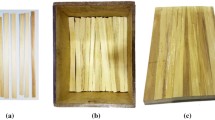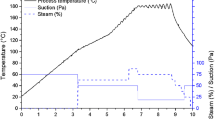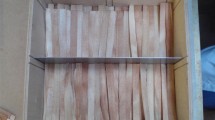Abstract
In this paper, the wettability of two different wood species as raw material for Oriented Strand Board (OSB) is analyzed. One species is pine, a common material for the production of OSB; the other species, poplar, and especially hybrid poplar, is newly used in OSB and might require a modified board production process compared to pine. Therefore, strands of hybrid poplar obtained from a central European poplar plantation were compared to pine strands in terms of surface characteristics and contact angles after application of the adhesives. For the contact angle measurement droplets of two types of adhesives, melamine urea formaldehyde (MUF) resin and polymeric methylene diphenyl diisocyanate (pMDI), were applied onto the surface of the strands. pMDI exhibited larger contact angles on poplar than on pine; but for both wood species the contact angles were low when compared to MUF. MUF values were much higher, but relatively similar numbers were measured for both wood species.
Zusammenfassung
In dieser Arbeit wird die Benetzbarkeit von zwei unterschiedlichen Holzarten, welche als Rohstoffe für die Erzeugung von OSB in Frage kommen, untersucht. Zum einen wurde Kiefer, ein gängiges Rohmaterial für die Erzeugung von OSB, zum anderen Pappel, die speziell in Form von Hybridpappelholz zunehmend Verwendung in der OSB-Herstellung untersucht Pappel, die speziell in Form von Hybridpappelholz zunehmend Verwendung in der OSB-Herstellung findet. Zu diesem Zweck wurden im Rahmen dieser Arbeit OSB-Späne (Strands) einer zentraleuropäischen Pappelplantage mit Kieferspänen hinsichtlich Oberflächenenergie und Benetzungsverhalten verglichen. Für die Kontaktwinkelmessung wurden die Harze Melaminharnstoff Formaldehyd (MUF) und polymeres Diphenylmethandiisocyanat (pMDI) in Tropfenform auf die Späne aufgetragen und die Kontaktwinkel gemessen. Das pMDI-Harz zeigte größere Kontaktwinkel auf Pappel als auf Kiefer, jedoch waren die Kontaktwinkel auf beiden Holzarten gering im Vergleich zu jenen von MUF. Die mit MUF gemessenen Kontaktwinkel zeigten im Vergleich zu pMDI wesentlich höhere Werte mit geringen Unterschieden zwischen den beiden Holzarten.




Similar content being viewed by others
References
Beaudoin M, Hernandez RE, Koubaa A, Poliquin J (1992) Interclonal, intraclonal and within-tree variation in wood density of polar hybrid clones. Wood Fiber Sci 24(2):147–153
Boehme C, Hora G (1996) Water absorption and contact angle measurement of native European, North American and tropical wood species to predict gluing properties. Holzforschung 50(3):269–276
Bogner A (1991) Improving adhesive quality by modification of wood surface. Holz Roh Werkst 49(7–8):271–275
Conrad MPC, Smith GD, Fernlund G (2004) Fracture of wood composites and wood-adhesive joints: a comparative review. Wood Fiber Sci 36(1):26–39
de Meijer M, Haemers S, Cobben W, Militz H (2000) Surface energy determinations of wood: comparison of methods and wood species. Langmuir 16(24):9352–9359
Feist WC, Hon DN-S (1984) Chemistry of weathering and protection. In: Rowell RM (ed) The chemistry of solid wood, vol 207. Advances in Chemistry. American Chemical Society, Washington. pp 401–451
Fowkes FM (1964) Attractive forces at interfaces. Ind Eng Chem 56(12):40
Geimer RL, Crist JB (1980) Structural flakeboard from short-rotation, intensively cultured hybrid populus clones. Forest Prod J 30(6):42–48
Gindl M, Sinn G, Gindl W, Reiterer A, Tschegg S (2001) A comparison of different methods to calculate the surface free energy of wood using contact angle measurements. Colloids Surf A 181(1–3):279–287
Gindl M, Reiterer A, Sinn G, Stanzl-Tschegg SE (2004) Effects of surface ageing on wettability, surface chemistry, and adhesion of wood. Holz Roh Werkst 62(4):273–280
Good RJ (1993) Contact angle, wettability and adhesion: a critical review. In: Mittal KL (ed) Contact angle, wettability and adhesion. VSP, Utrecht, pp 3–36
Gunnells DW, Gardner DJ, Wolcott MP (1994) Temperature-dependence of wood surface-energy. Wood Fiber Sci 26(4):447–455
Hameed M, Roffael E (1999) On the wettability of sapwood and heartwood of various woodspecies (Pine, Douglas fir and Larch). Holz Roh Werkst 57(4):287–293
Herczeg A (1965) Wettability of wood. Forest Prod J 15(11):499–505
Hernandez RE, Koubaa A, Beaudoin M, Fortin Y (1998) Selected mechanical properties of fast-growing poplar hybrid clones. Wood Fiber Sci 30(2):138–147
Higuchi T (1997) Biochemistry and molecular biology of wood. Springer, Berlin
Janssen D, De Palma R, Verlaak S, Heremans P, Dehaen W (2006) Static solvent contact angle measurements, surface free energy and wettability determination of various self-assembled monolayers on silicon dioxide. Thin Solid Films 515(4):1433–1438
Kaelble DH (1970) Dispersion-polar surface tension properties of organic solids. J Adhes 2(2):66–81
Kamke FA, Lee JN (2007) Adhesive penetration in wood—a review. Wood Fiber Sci 39(2):205–220
Kretschmann DE, Isebrands JG, Stanosz G, Dramm JR, Olstad A, Cole D, Samsel J (1999) Structural lumber properties of hybrid poplar. Res. Pap. FPL–RP–573. US Department of Agriculture, Forest Service, Forest Products Laboratory, Madison
Liptakova E, Kudela J, Bastl Z, Spirovova I (1995) Influence of mechanical surface-treatment of wood on the wetting process. Holzforschung 49(4):369–375
Maloney TM, Lentz MT, Canbron G (1995) Oriented strandboard from Douglas fir, hemlock, spruce, cedar, and poplar. Res. Rept. 3808–2996. Wood Materials and Engineering Laboratory, Washington State Univ., Pullman, WA
Nguyen T, Johns WE (1979) Effects of aging and extraction on the surface free-energy of Douglas-fir and redwood. Wood Sci Technol 13(1):29–40
Nussbaum RM (1999) Natural surface inactivation of Scots pine and Norway spruce evaluated by contact angle measurements. Holz Roh Werkst 57(6):419–424
Owens DK, Wendt RC (1969) Estimation of the surface free energy of polymers. J Appl Polym Sci 13(8):1741–1747
Peters JJ, Bender DA, Wolcott MP, Johnson JD (2002) Selected properties of hybrid poplar clear wood and composite panels. Forest Prod J 52(5):45–54
Rabel W (1971) Einige Aspekte der Benetzungstheorie und ihre Anwendung auf die Untersuchung und Veränderung der Oberflächeneigenschaften von Polymeren. Farbe und Lack 77(10):997–1005
Röhle H, Ali W, Hartmann K-U, Steinke C (2010) Wachstum und Biomasseproduktion schnellwachsender Baumarten im Kurzumtrieb. In: Bemmann A, Knust C (eds) Agrowood—Kurzumtriebsplantagen in Deutschland und europäische Perspektiven. Weißensee Verlag, Berlin, pp 103–116
Scheikl M, Dunky M (1996) Computerized static and dynamic contact-angle measuring methods in connection with wettability of wood. Holz Roh Werkst 54(2):113–117
Scheikl M, Dunky M (1998) Measurement of dynamic and static contact angles on wood for the determination of its surface tension and the penetration of liquids into the wood surface. Holzforschung 52(1):89–94
Semple KE, Vaillant MH, Kang KY, Oh SW, Smith GD, Mansfield SD (2007) Evaluating the suitability of hybrid poplar clones for the manufacture of oriented strand boards. Holzforschung 61(4):430–438
Shen Q, Nylund J, Rosenholm JB (1998) Estimation of the surface energy and acid-base properties of wood by means of wetting method. Holzforschung 52(5):521–529
Shi SQ, Gardner DJ (2001) Dynamic adhesive wettability of wood. Wood Fiber Sci 33(1):58–68
Sinn G, Gindl M, Reiterer A, Stanzl-Tschegg S (2004) Changes in the surface properties of wood due to sanding. Holzforschung 58(3):246–251
Smith GD (2005) The lap-shear strength of bonds between Oriented Strand Board (OSB) like strands coated with pMDI resin. Holz Roh Werkst 63(4):311–312
van Oss CJ, Good RJ, Chaudhury MK (1988) Additive and nonadditive surface-tension components and the interpretation of contact angles. Langmuir 4(4):884–891
Wagenführ R (1999) Anatomie des Holzes. DRW-Verlag, Leinfelden-Echterdingen
Walinder MEP, Strom G (2001) Measurement of wood wettability by the Wilhelmy method—Part 2. Determination of apparent contact angles. Holzforschung 55(1):33–41
Wegener G (1999) Oriented structural boards (OSB) from fast-growing poplar and willow in Industrial end uses of fast grown species. Paper presented at the Proceedings of the Eurowood Technical Workshop, Florence, Italy
Whitesides GM, Biebuyck HA, Folkers JP, Prime KL (1991) Acid-Base Interactions in Wetting. J Adhes Sci Technol 5(1):57–69
Young T (1805) An essay on the cohesion of fluids. Trans R Soc 95:65–87
Zhang XL, Gardner DJ, Muszynski L (2009) Ultrasonic atomization of pMDI wood resin. Wood Fiber Sci 41(1):84–89
Author information
Authors and Affiliations
Corresponding author
Rights and permissions
About this article
Cite this article
Rathke, J., Sinn, G. Evaluating the wettability of MUF resins and pMDI on two different OSB raw materials. Eur. J. Wood Prod. 71, 335–342 (2013). https://doi.org/10.1007/s00107-013-0675-6
Received:
Published:
Issue Date:
DOI: https://doi.org/10.1007/s00107-013-0675-6




